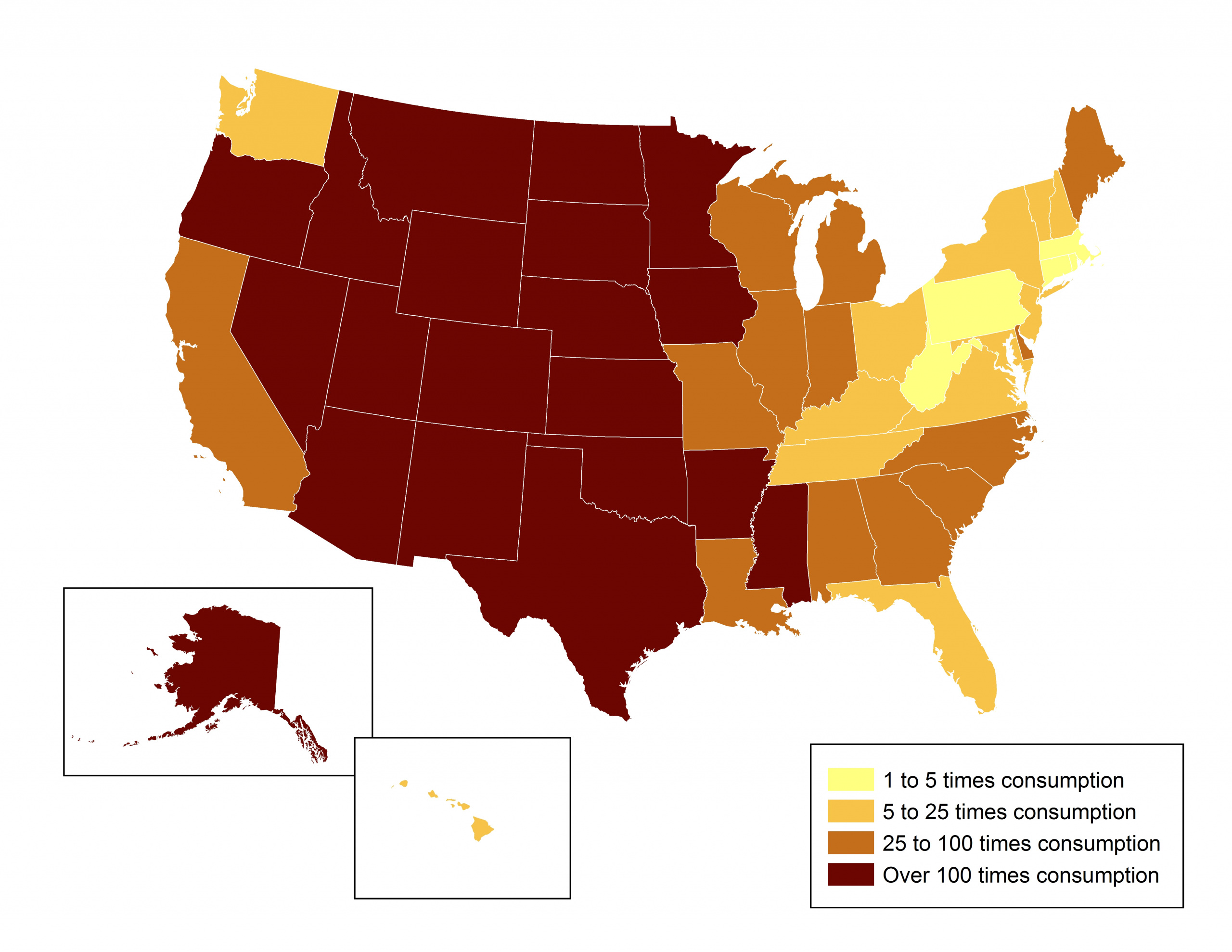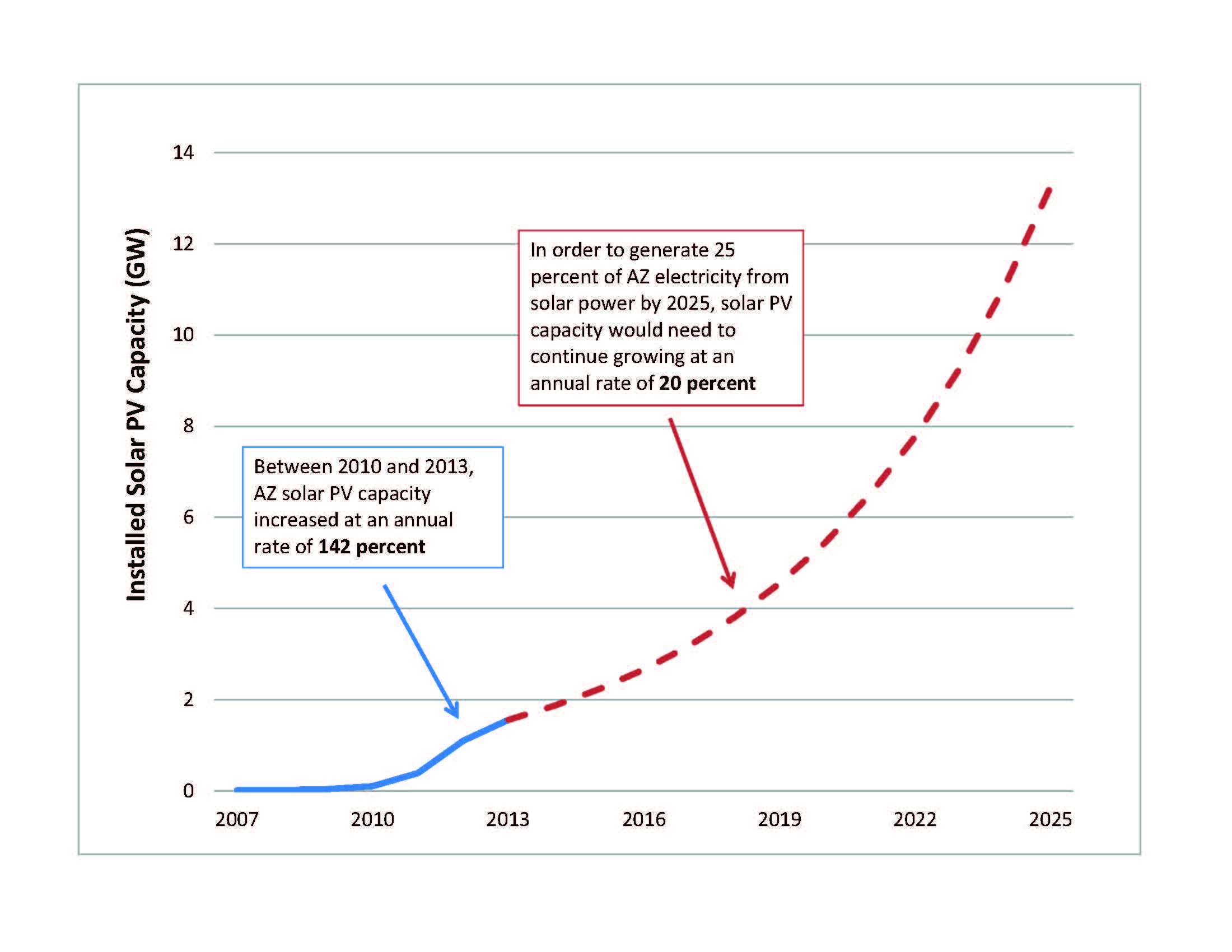Star Power: The Growing Role of Solar Energy in Arizona
Our new report shows that tapping just a fraction of our state’s solar potential will yield tremendous benefits for our lives, our environment and our children’s future. The report also demonstrates that the rapid growth of solar makes goals what once seemed ambitious readily achievable.
Downloads
Arizona could meet its energy needs by capturing just a sliver of the virtually limitless and pollution-free energy that strikes the state every day in the form of sunlight. With solar installation costs falling, the efficiency of solar cells rising, and the threats of air pollution and global warming ever-looming, solar power is becoming a more attractive and widespread source of energy every day.
Solar energy is on the rise across the country. The amount of solar photovoltaic (PV) capacity* in the United States has tripled in the past two years. More than half of all new U.S. electricity generating capacity came from solar installations in the first half of 2014, and the United States now has enough solar electric capacity installed to power more than 3.2 million homes. Arizona installed more solar electric capacity than any other state in 2013, and it was the state with the highest amount of installed solar capacity per person at the end of that year.
Arizona should build on the recent growth in solar energy by setting a goal of obtaining at least 25 percent of its electricity from solar power by 2025. Achieving that goal would result in a cleaner environment, less dependence on fossil fuels, and a stronger economy.
Arizona’s solar energy potential is nearly limitless. Based on renewable energy technical potential reported by the National Renewable Energy Laboratory:
- Arizona has the potential to produce more than 320 times as much electricity from solar PV and concentrating solar power (CSP) installations as the state consumes each year. Each of the 50 states has the potential to generate far more electricity from the sun than its residents consume. (See Figure ES-1).
- There are 35 million residential and commercial rooftops that could host solar panels across the United States, including more than 800,000 rooftops in Arizona.
Continued growth in solar energy would bring a goal of 25 percent solar electricity within reach.
- Solar PV capacity in Arizona increased at a rate of 142 percent per year from 2010 to 2013. If solar PV installations continue to increase at just one-seventh of that rate (20 percent) annually between 2013 and 2025, Arizona would have enough solar energy to generate 25 percent of its electricity. (See Figure ES-2).
Figure ES-1: Solar Electricity Technical Potential Compared with Electricity Consumption

Figure ES-2: Arizona Can Generate 25 Percent of Its Electricity from Solar Power by 2025

Getting at least 25 percent of Arizona’s electricity from the sun by 2025 would represent a major step toward stabilizing the climate, cleaning our air and building a prosperous, sustainable economy.
- Producing 25 percent of its electricity from clean, solar power would reduce Arizona’s global warming pollution by 13 million metric tons in 2025 – the equivalent of taking 2.8 million cars off the road. Solar energy at that scale would help Arizona comply with the goals of the Clean Power Plan – the Environmental Protection Agency’s (EPA’s) proposed plan to reduce U.S. global warming pollution from the power sector by 30 percent below 2005 levels by 2030. If the EPA decides that distributed generation can help states achieve their goals under the Clean Power Plan, producing 25 percent of Arizona’s electricity from clean, solar power would enable the state to achieve more than half of its 2030 emission reductions goal.
- Expanding solar energy will also reduce emissions of pollutants that contribute to the formation of smog and soot and threaten public health, especially the health of vulnerable populations like children, the elderly and those with respiratory disease.
- Obtaining 25 percent of Arizona’s electricity from solar energy would reduce water consumption from power plants dramatically. Using a life-cycle assessment, solar photovoltaics consume 1/500th of the water consumed by coal power plants and 1/80th of the water consumed by natural gas plants per unit of electricity produced.
- Solar energy creates local clean energy jobs that can’t be outsourced. Growth in the solar industry from November 2012 to November 2013 was 10 times faster than the national average for employment. Arizona is the state with the second-greatest number of solar jobs – more than 8,500 Arizonans worked in the solar energy industry in 2013.
A future in which Arizona gets at least 25 percent of its electricity from the sun is within reach. Leadership in Arizona will help America generate 10 percent of its electricity from solar power by 2030. The tools to build this vision are available and the momentum exists – now federal, state and local governments should adopt aggressive goals for solar integration and implement policies that encourage the adoption of solar power.
To achieve Arizona’s full solar potential:
- Arizona’s state government should commit to obtain at least 25 percent of its electricity from solar power by 2025 and adopt policies to achieve that goal. Arizona should also maintain strong net metering and interconnection standards, promote community solar and virtual net metering that can deliver the benefits of solar power to low income communities, facilitate third-party sales of solar power to provide access to successful solar leasing programs, and make smart investments to move toward a more intelligent electric grid in which distributed sources of energy such as solar power play a larger role. The state should utilize solar energy wherever possible on public buildings and properties. Arizona should adopt a strategy for complying with the Clean Power Plan, and solar power should play a significant role in the state’s plans to meet or exceed the emission reduction targets.
- The federal government should commit to a baseline goal of obtaining at least 10 percent of the nation’s electricity from solar energy by 2030. The federal government should utilize solar energy on government buildings and also continue successful solar policies, including federal incentives, programs to responsibly site solar energy on public lands, and research, development and deployment efforts designed to help local and state governments reduce the cost of solar energy and smooth the incorporation of large amounts of solar energy into the electric grid. It should consider adopting a baseline standard for net metering. In addition, the federal government should strengthen and finalize the Clean Power Plan and ensure that distributed electricity resources such as rooftop solar panels can be used as a tool for compliance.
- Local governments should adopt strong solar goals, utilize solar energy wherever possible on public buildings and properties, ensure that homeowners and businesses can “go solar” easily and with a minimum amount of red tape, implement financing programs, such as property-assessed clean energy (PACE) financing, and adopt bulk purchasing programs for solar installations. Local governments should also establish zoning and building codes that facilitate the use of solar energy. Municipally owned utilities should promote solar energy by providing net metering or other rate structures to compensate solar homeowners fairly, and by making investments in community-scale and utility-scale solar projects.
* In this report, “solar photovoltaic (PV) capacity” or “solar PV” refers to installed solar photovoltaic systems, both distributed and utility-scale. “Solar electricity capacity” refers to all solar technologies that generate electricity, including concentrating solar power systems that use the sun’s heat – rather than its light – to generate electricity. The figures in this report do not include other solar energy technologies, such as solar water heating.

